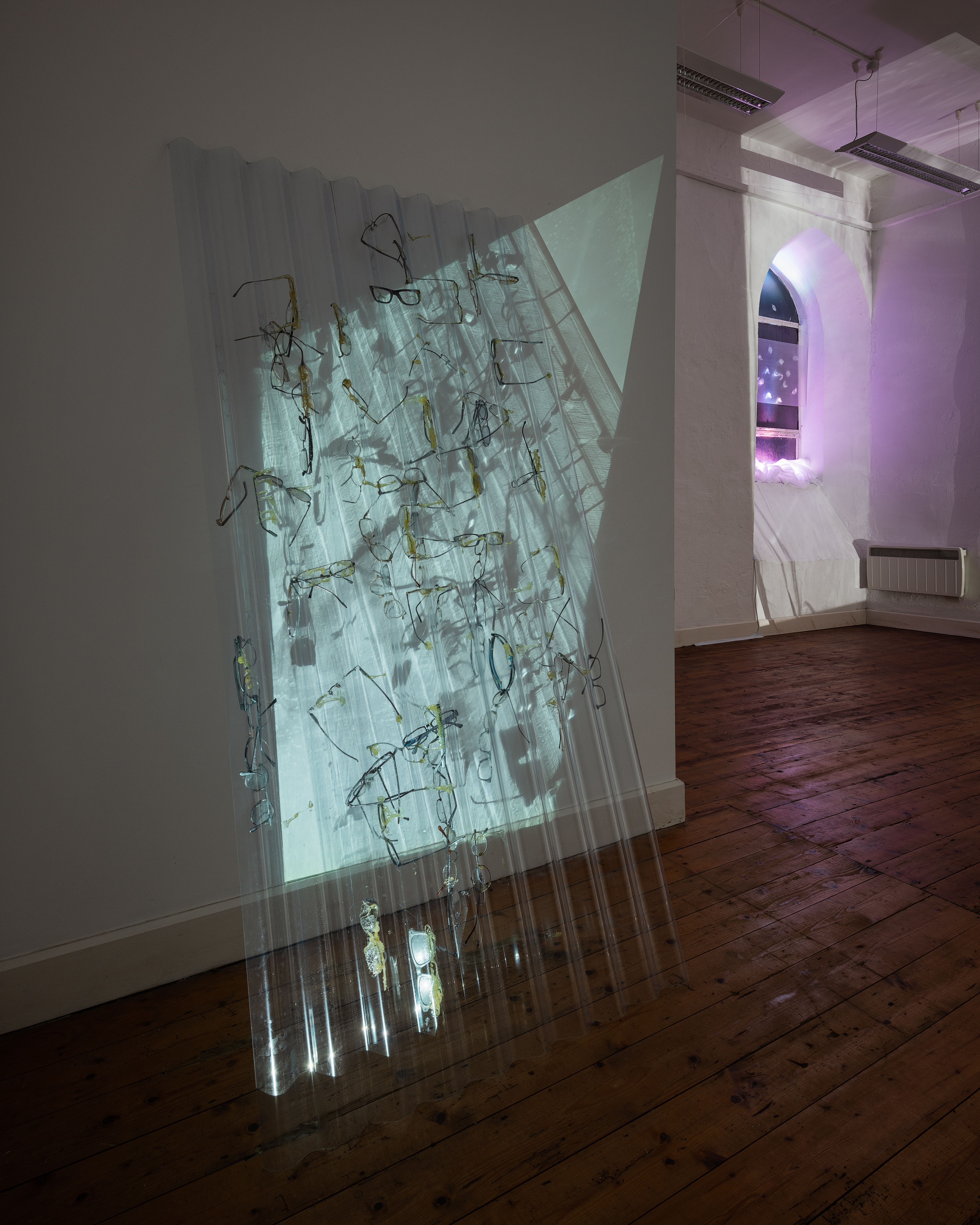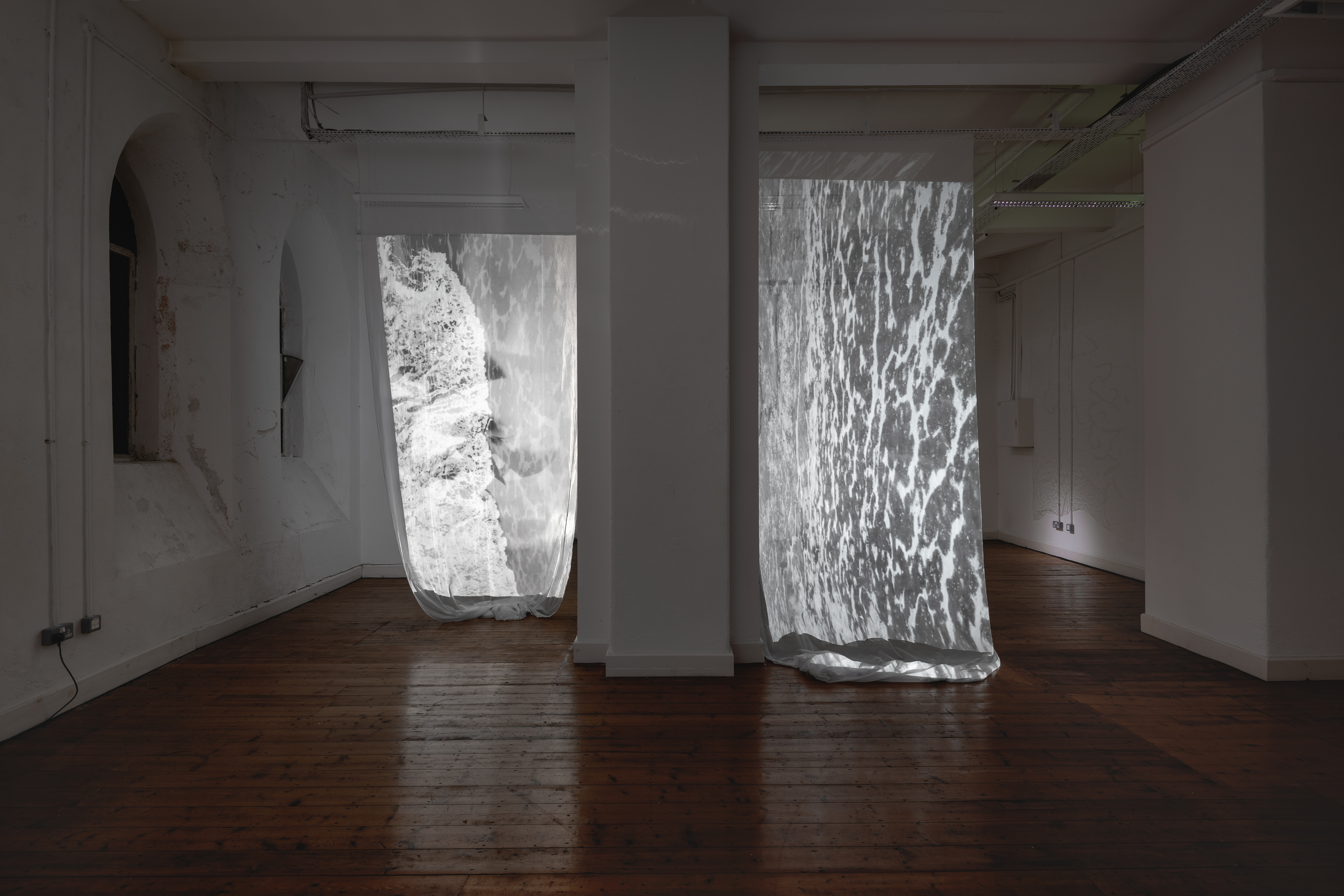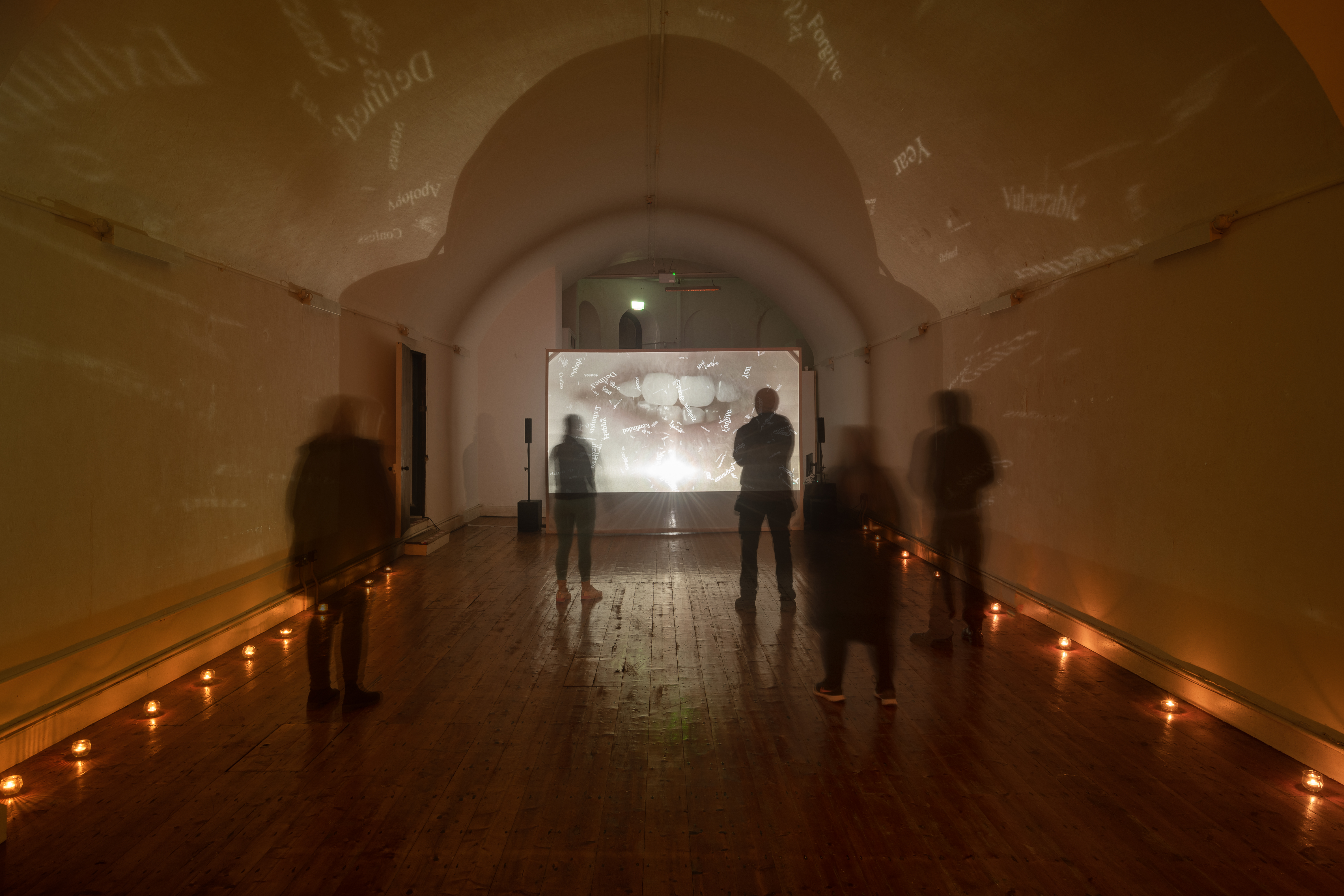
THE SYNERGISTIC REVIEW
In answer to the question, who benefits from artistic critique? Jennifer Redmond and Aoife Claffey collaborate to evaluate Claffey’s recent solo show Mystical Confessions. Redmond reviews the work and Claffey responds in the recorded dialog below.
On December 8th and 9th of 2021 Aoife Claffey supported by Sample studios, installed a solo show at the Crypt in St Luke’s Church in Cork. Bear in mind that this was the middle of the winter, dark cold, with hardly any other public venues open. The show was under constant threat of cancellation, and Covid-19 was still a menace to public health.
The event was conceived and realised in precarious circumstances, there was the ever present threat of cancellation – a week cut down to two days, then two days cut down to one. Only the most determined soul would persevere under these conditions; respect is due to Aoife Claffey for her forbearance and determination.
We lined up in the dark freezing fog and mist until our Covid passports and masks were checked and slipped cautiously through the portal.
A crypt is the stone chamber beneath a church – not every church, but rooms used as burial chambers for important dignitaries in a religious order or for benefactors and denizens of the town. They are not often occupied by the living. They might be considered as heterotopic spaces, full of shadows and chimeras, and spectral phenomena.
Claffey worked with the incorporeal feel of the space by accentuating the unearthly, the shadowy and the eerie; using smoke machines and candlelight and binaural soundscapes.
It was probably a no brainer given the time of year (just prior to Christmas) and the site (a protestant church and confession is a catholic sacrament) to call the show Mystical Confessions. Claffey says Her work is influenced by her interest in both material culture and the physical exploration of non-spaces. I am not sure what she defines as a ‘non-space’ because I felt very deliberately situated. She says that; ‘…physiological and psychological tensions between chaos and order are encouraged both during the making, and within the work, to evoke immersive uncanny effects or altered cognitive states.’
I asked myself did my physiological and psychological being undergo an altered state while I was in the space with the work? Well, the dark was disorientating, and lots of old religious memories were triggered by the smells and smoke from the machines, from the dim mirror imagery and from the candles.
Some old oppressive feelings did kick in but I don’t think that my cognitive state was altered and this in part, is probably due to a kind of personal shield that is general in the viewing public. We are so accustomed to exhibitions, films, games, trying to alter our cognitive states with atmospherics that we have come to expect it and have developed strategies to negotiate such events.
Altered cognitive states are hard to manipulate(legally)in others as a general rule. It is more usually achieved by layered meaning than by atmospherics. We can tend to be cynical about attempts to manipulate us, and the uncanny has become more normative than most realise. I think that a more interesting question for Claffey to tackle might be why she wants to alter the normative cognitive mind state common to a majority.

All that said, I rather enjoyed the atmospherics, the chimeras, projections onto flowing drapes and the dark. The theatrics – a stage set for the exhibits many of which were comprised of light in some form. Hardly a material at all. A human will always gravitate towards the light. And yes, it was immersive but I am wondering how much that staging contributed towards the work. I am always worried that staging will somehow trick me into thinking the way the someone wants me to think and it makes me suspicious that some clever sorcery is afoot.
Claffey says that she is interested in exploring human sensory perception within immersive environments. She states that she is questioning how one physically expresses their energy and their vulnerability.
To this end she has solicited one hundred ‘honest’ confessions from an online anonymous survey link.(unspecified) So that it appears she has allowed random participants to avail of a confessional service.
She has used these declarations to make an interactive projected work and has installed shrines to these acts of contrition marked by a candle flame for the congregated viewers to identify with be reflected in and to ponder their own vulnerabilities and flawed demons.

Claffey seems to be suggesting that this activity might throw us into stasis and make us consider the integrity and privilege of being conscious. Consciousness understood as a rational consciousness, or at least make us question the consensual cultural value system that prevails.
She has created this ‘non-space’ for ‘…the viewer to recall the peripheral’ (or perhaps a third space?) that is in perpetual transformation.
But Aoife, I would argue that the world is in a continual state of flux anyway, is it that you are hoping to trigger disquiet as a portal to something else? Again I think that the question is why is it important to interrupt rationality and the human behaviours that result from it.



Let’s look at the work?
‘Being around people for too long exhausts me’
‘I absolutely hate being cold’
‘I get angry easily’
‘The last two years have been the hardest mentally for me’
These are some of the statements submitted to the survey. Claffey has broken these sentences down to form a word bank and from this, she has created interesting text animations; some involving mirror imagery and a generative movement sensitive, random scattering of words cast onto a screen on the south wall of the crypt.
This scatter-bombing of words suggests the chaos or brain fog that might accompany admissions of character flaws and vulnerability. As if you can get too near to an admission and can sweep the words away from your consciousness and avoid the whispering lips that fade in and out of the projection leaving a deluge of undigested misery in its wake.
The corbelled ceiling becomes the part of the installation, in case you think that you can get away from the confessions you will find that the words are all around you seeping into your consciousness and perhaps into your subconsciousness too. Why do we feel so much guilt? Is it entirely the fault of an overdeveloped consciousness – or a nurtured condition?
This is an engaging piece, while in the gallery space I watched people play with the installation running up to it and causing the gathered letters to scatter and to be swept to the side of the screen as if creating a space – a space for what? For your own confessions. Even if you just want to play with the exhibit or to cast your
personal physical shape in the glare of the projections, you are interacting with the work. You are not bored. The danger with this is that the entertainment value might be the only thing that the viewer will take away.

Much of the work in this exhibition is nebulous, projected, ephemeral and yet Claffey alludes to the relationship between the human and ‘disposable’ materiality of objects such as false teeth and glasses. (presumably we could include other prosthetic objects that live in close relation with a human body)
She presents a collection of discarded false teeth and of cast off/withdrawn spectacles ensnared on corrugated plastic sheeting and backlit against a shadowy wall, or false teeth up lit in a window alcove.
Is this an attempt to suggest that the agency of these objects is reduced to aesthetic sensory or hallucinatory apprehension.
She seems to be implying that these are objects haunted by some hidden surplus and perhaps massively distributed globally. Which when considered in the light of social ontology all seems to point towards an entropic society, an accelerating sullied and uncaring state of being.
Claffey asserts that her creative process is to relinquish control and that she likes a certain serendipity to be evident in the making and appreciating of her work.
In this exhibition there is; surround sound, interactive projections, reflective found objects – which is a lot to control. But there is also a sense of fragility, of anxiety towards an unfathomable future and a sense of haunting, a feeling that reality is a game of smoke and mirrors no longer underpinned by spirituality or rationality.








This work is licensed under a Creative Commons Attribution-NonCommercial-NoDerivatives 4.0 International License.